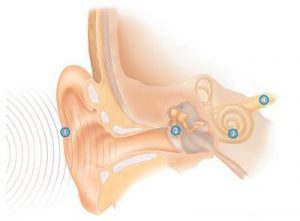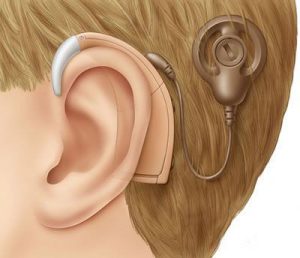Source: Municipality of Aarhus Hospital
A cochlear implant is an electronic device (CI) which takes over the function of a defective inner ear (cochlea). It does this by converting acoustic information into electrical impulses that are sent directly to the hearing nerve using implanted electrodes. To understand how CI works, one must know the structure of a normal ear.
How a normal hearing ear works:

- The sound is picked up by the outer ear and transmitted through the ear canal to the tympanic membrane. The sound sets the eardrum to vibrate.
- The sound is amplified through the small tympanic (hammer, anvil and stirrup) and sent to the oval window of the cochlea.
- Snail sound is sent through the fluid and stimulating “hair cells”. The “hair cells”, first reached form bright tones ( “highs”). Further up in the auger gets the tones darker ( “deep”).
- From the “hair cells” sound is sent further along the auditory nerve to the brain.

How the cochlear implant works
A CI consists of an inner member and an outer member. The outer part consists of speech processor, microphone and transmitter. The microphone picks up sounds and sends them to the speech processor. Speech processor is a small computer that processes sound and sends it to a small transmitter. It’s stuck on a magnet, the second part is placed under the skin by surgery.

The transmitter transmits signals through the skin to the implant. The inner part (the implant) which outputs sound on to the auditory nerve, is made up of the decoder and the electrodes, which are connected to each other. The decoder picks up the sound from the microphone. The electrodes, which are operated into the auger replace the damaged “hair cells”.
Speech is a combination of sounds, containing different frequencies. Cochlear implant analyzes the frequency content of the speech and sends it via electrodes in CI on to the auditory nerve as electrical pulses.
Who can benefit from CI?
- Patients with sudden deafness.
- Patients whose hearing has become so poor that they hardly enjoy hearing aid processing.
- Patients who are born deaf or become deaf before they learned the language, can only cope with a little sound perception. Because the hearing center of the brain have not been stimulated / used for many years, it can not be rehabilitated, so patients can learn to understand spoken language.
- The patient’s health must be so good that he is able to tolerate anesthesia and to undergo a surgery that lasts about three hours.
- The patient must be prepared for the rehabilitation of the “new hearing” so they learn to use it optimally.